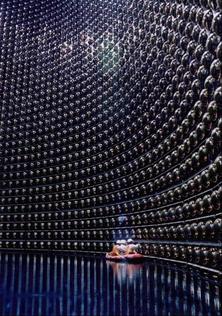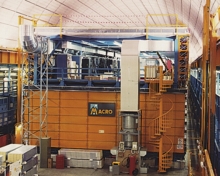Research Interests:
Professor James Stone conducts research in experimental elementary particle physics by seeking evidence for the unification of the strong and electroweak forces of nature. His work involves massive experimental detectors located in deep underground laboratories used to mount searches for the spontaneous disintegration of matter (proton decay); for the existence of massive magnetic monopoles in the cosmic radiation; and for neutrino flavor oscillations of atmospheric, solar, and accelerator produced neutrinos. Significant evidence for neutrinos having mass was discovered in 1998 by the Super-Kamiokande Collaboration in Japan. Professor Stone is the Co-Spokesman for the U.S. Super-Kamiokande Collaboration. The SuperK detector, a 50,000 metric ton water Cherenkov device, provided the first conclusive evidence for the flavor oscillation of atmospheric neutrinos. The quest for proton decay, which began with Stone's work on the IMB experiment, continues with the SuperK experiment, but none have been found, setting the most sensitive experimental limits to date for the proton lifetime (>10**33 years). The SuperK experiment continues to answer important questions in neutrino physics. For the K2K (KEK to Kamioka) experiment, the SuperK detector was used to confirm muon neutrino disappearance effects seen in atmospheric neutrinos by using a beam of neutrinos produced at the KEK proton accelerator and directed 250 kilometers through the earth to the SuperK detector. In the next decade, the upgraded SuperK-III detector will be the primary component for the T2K (Tokai to Kamioka) long baseline neutrino experiment. T2K seeks to measure a neutrino mixing parameter, which if found to be non-zero, could signal the possibility of CP violation in the lepton sector, which in turn could explain the apparent domination of matter over anti-matter in the universe. In 1987, while a member of the IMB Experiment (predecessor of SuperK), Stone and his group detected a burst of neutrinos correlated with supernovae SN1987a, which appeared in the Large Magellanic Cloud on February 23, 1987. This observation was awarded the Bruno Rossi Prize by the American Astronomical Society. The watch for neutrino bursts from galactic supernovae is a continuing vigilance for the Super-Kamiokande Collaboration. * "The Super-Kamiokande Proton Decay and Neutrino Experiment":/static/superk.html * "The K2K Long Baseline Neutrino Oscillation Experiment":http://hep.bu.edu/~superk/k2k.html * "The MACRO Experiment":/static/macro.html
In the news:
- Neutrino Nobel has BU connections
- First Long-Baseline Neutrino in T2K
- Professor James Stone selected as 2009 Jefferson Science Fellow
Research Descriptions:
Neutrino Physics and Astrophysics

As a sequel to the combined effort of the two earlier deep underground ring-imaging detectors, IMB and Kamiokande, Super-Kamiokande started recording data deep inside a lead and zinc mine in the Japanese Alps in 1996. The detector is a 40-meter high by 40-meter diameter stainless steel tank, filled with 50,000 tons of ultra-pure water. The walls of the tank are lined with 11,200 photomultiplier tubes, each an enormous 50 centimeters in diameter. One half of the surface of the tank is covered by photosensitive material. These tubes record the Cherenkov light from charged particles as they pass through the water.
Physicists in the US and in Japan designed Super-K to search for, in part, the radioactive decay of the proton, a rare event never before observed. Detecting proton decay would confirm the Grand Unified Theory of particle physics.
Though Super-K has yet to detected a single candidate, it observed something equally intriguing: convincing evidence that neutrinos have mass. Because neutrinos carry no charge, they rarely interact with other particles. Billions go through each of us every second without effect. But since Super-K is so large, it detects a handful of these neutrinos each week. Using the data collected by Super-K, researchers including Boston University physicists Jim Stone (US co-spokesman), Larry Sulak and Ed Kearns confirmed results from the two precursor experiments that about half the neutrinos expected were unseen.
Neutrinos come in three species – the tau neutrino, the muon neutrino, and the electron neutrino. Super-K discovered that these neutrino species transform into each other. If oscillations occur, muon neutrinos could transform into tau neutrinos, and the missing neutrinos observed by Super-K would be explained. This was documented in the 1999 Ph.D. thesis of Boston University graduate student Mark Messier. Quantum mechanically, for these oscillations to occur, the neutrino must have mass. Several experiments since this revelation in 1998 have reinforced this interpretation.
The discovery of massive neutrinos has forced theorists to rethink the Standard Model of particle physics; neutrino mass is not anticipated in this most accurate and predictive of theories. Further, with mass, the neutrinos in the universe account for nearly as much mass as all the stars. Hence, they would influence the formation of galaxies in the early universe. This discovery is the first indication of new physics beyond the Standard Model.
The MACRO Experiment: Monopole Astrophysics and Cosmic Ray Observatory
The deep underground MACRO detector operated at the Laboratori Nazionali del Gran Sasso in Abruzzo, Italy from 1990 to 2000. MACRO had a geometrical acceptance of 10,000 square meters at an average depth of 3.8 kilometers of water equivalent under the mountainous overburden of the Gran Sasso d'Italia. The MACRO detector was used to research several topics. The specialty of MACRO was the search for magnetic monopoles: particles with bare north or south magnetic charge. These particles are a natural consequence of Grand Unified Theories, which also predict that the monopole will be very massive, perhaps 10 to the power 16 GeV. Such particles can only be produced by the intense energies available during the big bang. MACRO operated like a giant Time-Of-Flight counter to detect the unique signature of a slow moving but penetrating massive particle. It was equipped with tanks of liquid scintillator, planes of streamer tubes and plates of track etch material in the hopes of recording a convincing signature from a single candidate event. MACRO's high-resolution tracking and timing were also used to perform high statistics measurements of cosmic ray muons; in particular, the scintillator timing was used to distinguish upward going muons produced by neutrino interactions in the rock. This was an opportunity to investigate the possible flavor oscillation of massive neutrinos as suggested by the atmospheric neutrino puzzle, and MACRO was the first experiment to independently confirm the atmospheric neutrino oscillation signal seen by Super-Kamiokande.
 Physics (Internal)
Physics (Internal)

